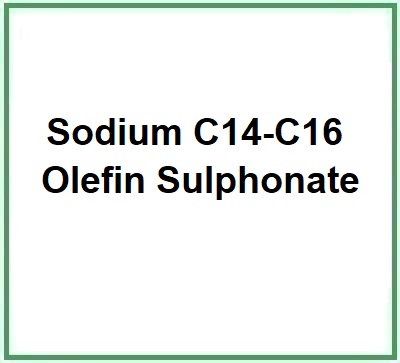Sodium C14-C16 Olefin Sulphonate is a chemical compound consisting of sodium salts, C14-16-alkane hydroxy, C14-16-alkene, sulphonic acids.
The name describes the structure of the molecule:
- Sodium indicates the presence of a sodium cation in the molecule, making the compound water-soluble.
- C14-16 indicate the carbon chain length of the olefins, ranging between 14 and 16 carbon atoms.
- Olefin. Olefins are unsaturated hydrocarbons with at least one double bond between two carbon atoms in the molecule.
- Sulfonate. This indicates the presence of a sulfonate functional group, which imparts detergent and foaming properties to the compound.
Raw Materials Used in Production.
- C14-16 Olefins are unsaturated hydrocarbons that can be sourced from the likes of vegetable oils or petroleum.
- Sulfonating agents such as sulfur trioxide, which is used to introduce sulfonic groups into molecules.
Step-by-step Summary of Industrial Production Process.
- Production of olefins. C14-16 olefins can be obtained through processes like the thermal cracking of vegetable oils or petroleum.
- Sulfonation reaction. The olefins react with sulfonating agents, such as sulfur trioxide, to produce the corresponding sulfonate.
- Neutralization. The resulting acid product is neutralized with a sodium hydroxide (caustic soda) solution to produce the sodium salt.
- Purification. The product is purified to remove impurities and byproducts.
Form and Color.
Sodium C14-16 Olefin Sulfonate typically appears as a clear liquid or as a white granular solid.

What it is used for and where
Cosmetics
Cleansing agent. Ingredient that cleanses skin without exploiting the surface-active properties that produce a lowering of the surface tension of the stratum corneum.
Foaming. Its function is to introduce gas bubbles into the water for a purely aesthetic factor, which does not affect the cleaning process, but only satisfies the commercial aspect of the detergent by helping to spread the detergent. This helps in the commercial success of a cleansing formulation. Since sebum has an inhibiting action on the bubble, more foam is produced in the second shampoo.
Surfactant - Cleansing agent. Cosmetic products used to cleanse the skin utilise the surface-active action that produces a lowering of the surface tension of the stratum corneum, facilitating the removal of dirt and impurities.
CAS 68439-57-6
EC number 270-407-8 931-534-0
Safety
Ingredient generally considered safe even though a 2014 study found that it can irritate the skin (1).
References_______________________________________________________________________
(1) Gerster FM, Vernez D, Wild PP, Hopf NB. Hazardous substances in frequently used professional cleaning products. Int J Occup Environ Health. 2014 Jan-Mar;20(1):46-60. doi: 10.1179/2049396713Y.0000000052.
Abstract Background: A growing number of studies have identified cleaners as a group at risk for adverse health effects of the skin and the respiratory tract. Chemical substances present in cleaning products could be responsible for these effects. Currently, only limited information is available about irritant and health hazardous chemical substances found in cleaning products. We hypothesized that chemical substances present in cleaning products are known health hazardous substances that might be involved in adverse health effects of the skin and the respiratory tract. Methods: We performed a systematic review of cleaning products used in the Swiss cleaning sector. We surveyed Swiss professional cleaning companies (n = 1476) to identify the most used products (n = 105) for inclusion. Safety data sheets (SDSs) were reviewed and hazardous substances present in cleaning products were tabulated with current European and global harmonized system hazard labels. Results: Professional cleaning products are mixtures of substances (arithmetic mean 3.5 +/- 2.8), and more than 132 different chemical substances were identified in 105 products. The main groups of chemicals were fragrances, glycol ethers, surfactants, solvents; and to a lesser extent, phosphates, salts, detergents, pH-stabilizers, acids, and bases. Up to 75% of products contained irritant (Xi), 64% harmful (Xn) and 28% corrosive (C) labeled substances. Hazards for eyes (59%) and skin (50%), and hazards by ingestion (60%) were the most reported. Conclusions: Cleaning products potentially give rise to simultaneous exposures to different chemical substances. As professional cleaners represent a large workforce, and cleaning products are widely used, it is a major public health issue to better understand these exposures. The list of substances provided in this study contains important information for future occupational exposure assessment studies.
![]() Sodium C14-C16 Olefin Sulphonate
Sodium C14-C16 Olefin Sulphonate 


